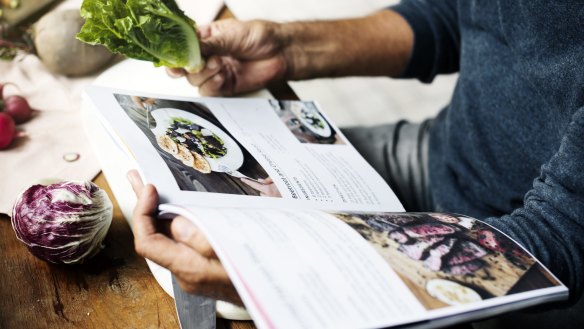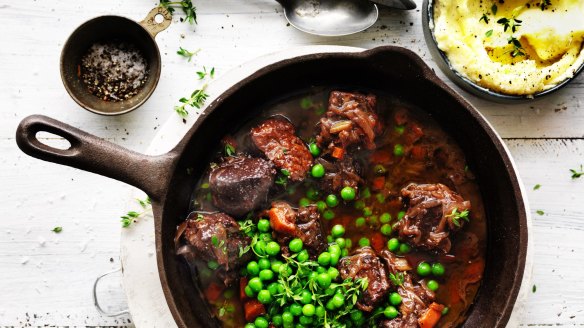Step-by-step: How to read and follow a recipe

My husband is a great instinctive cook but if he's following a recipe, he behaves as though he's been handed a set of ancient hieroglyphics. He constantly asks what he should do next and misreads steps. Once, he was blind-baking puff pastry and used the contents of a tin of baked beans instead of baking beans. Luckily the baking paper absorbed most of the sauce.
Most experts say the golden rule is to read the entire recipe through before starting. "I read it through twice if there's anything that's confusing," says caterer Sarah Mayoh, who also develops and tests recipes for magazines and cookbooks. "Target any potential pressure points and familiarise yourself with those processes. Prep as much as possible beforehand – anything you can have chopped, peeled or grated ahead of time will make things easier. Be prepared so you can relax and enjoy the cooking process."
For Barbara Sweeney, a food writer, cooking teacher and the founder of Food and Words, which hosts literary-themed food events, enjoyment is key. Sweeney, who says she learned to cook through cookbooks, says people shouldn't be afraid of recipes or of things going wrong. "People usually give up just before the matter will resolve itself," she says. "If they're kneading dough, they'll stop just before the gluten shifts and it becomes the right consistency. My advice is to be brave and keep going."
Mayoh agrees. "You need to relax and not feel pressured. The recipe is a great tool to guide you." She also says mistakes can sometimes have wonderful outcomes. "Don't be afraid to adjust as you go. As you become more confident, you can add your own spin on things."
Here's how to work your way through Neil Perry's recipe for red wine braised beef (click the bolded text for more detail).

The recipe: Neil Perry's red wine braised beef
This braise is great with secondary cuts of beef such as chuck, shin or cheek. It screams out for potato puree, but risoni folded through with melted butter will do just as nicely.
2 tbsp extra virgin olive oil
1kg trimmed beef brisket cut into 4cm chunks
3 garlic cloves, thinly sliced
2 celery stalks, finely chopped
2 small carrots, finely chopped
sea salt, to taste
375ml full-bodied red wine
2 fresh bay leaves
1. Preheat the oven to 170C. Heat half the olive oil in a large, flameproof casserole dish on medium to high heat.
2. Add the beef and cook for about eight minutes until browned, then transfer to a plate.
3. Reduce the heat to medium and add the remaining oil to the casserole dish. Add the garlic, onions, celery, carrots and sea salt to taste. Cook for 10 minutes or until the vegetables have softened.
4. Pour in the wine and simmer for five minutes, then add the bay leaves, thyme, stocks and a grind of black pepper. Return the beef to the casserole dish, place a sheet of baking paper directly on top of the liquid, and bring to the boil.
5. Put lid on the casserole dish and transfer to the oven for two-and-a-half to three hours, or until beef is very tender.
6. Use a slotted spoon to transfer the beef and vegetables onto a plate. Place the casserole dish over medium heat on the stove and simmer for about 15 minutes until the sauce has slightly reduced.
7. Return the beef and vegetables to the sauce, add the peas and cook until the peas are tender. Serve immediately.
Serves 4
The ingredients list
Check you have everything that's listed. If there's anything unusual, Mayoh advises researching it and not being afraid to substitute it if you can't find it.
Ingredients are usually listed in the order they are used so if you're completing the recipe in different stages, such as prepping in the morning and finishing it off when you get home, scanning the ingredients list will help you work out how to divide up your time.
Cuts of meat: "You can use any cuts that aren't prime, with interconnecting tissue that requires long, slow cooking to break down," says Sweeney.
Chunk size: Sweeney says you can experiment here. She followed a tip to make her chunks of meat bigger – about 6-8cm – and "it created a completely new dish. It was even more succulent."
Measurements and actions: Pay attention to the comma between measurements and actions. In most cases, the actions (in this case cutting, thinly slicing and finely chopping) are done after the ingredient is measured. But if a recipe calls for 1 cup chopped walnuts, with no comma, you need to do the chopping first, then measure out the nuts.
Finely chopped: The celery and carrot needs to be cut into similar sizes – smaller than just "chopped" and larger than "minced". This allows for a distribution of flavour and texture and will mean all the pieces cook at the same time.
Proportions: The proportions of each ingredient to the others is important. "If you decide to go hell for leather with garlic or thyme, that's fine, but the first time I cook a dish I try to stick as closely as possible to what is written. I make adjustments the next time I cook it," says Sweeney.
Unlike baking, you can be less precise with the measurements when you're cooking but it may taste a little different to what the recipe writer intended.
Method
Make sure you have all the equipment you need before you start.
Heat: Medium heat is different to high heat. "Most people cook at too high a heat," says Sweeney. "They're in a hurry; they haven't given themselves over to cooking." The word "braise" is the clue. It comes from the French "braiser" and means the food is first seared at a higher temperature, then simmered in a small amount of liquid in a covered pot.
Equipment: The recipe calls for a casserole dish. Sweeney says often a recipe doesn't work because you haven't used the right-sized pan. If it's too big and you're braising, you'll lose too much liquid. "You have to reflect on volume and adjust the cooking times."
The quality of your equipment is also important. "If you use a cheap aluminium saucepan it's more likely the onion will catch and burn when you're frying it." Sweeney loves her cast-iron casserole dish but she says, "Don't let not having the specified equipment stop you from cooking something. You can negotiate."
Browning meat: "People are afraid of cooking meat," says Mayoh. "Take the extra time you need for it to change colour." She advises cooking it in batches so you don't overcrowd the pan. The caramelisation is important for flavour.
Time v visual references: "Take all time references with a grain of salt," says Mayoh. "Everyone's stove and oven is different; you may have chopped the vegies different sizes." The visual reference – "until softened" – is always more important.
"Sweating onion and garlic takes time," says Sweeney. "If you go on to the next step too early, it'll be raw. The initial frying is the first layer of flavour, so it's critical. Turn down the heat, chill out and have a glass of wine."
Simmer: "The word 'simmer' tells you to turn down the heat," says Sweeney. "The surface should shimmer but not have lava blowholes in it. Keep adding liquid if it's too volatile."
Cartouche: This is a French word for a circle of greaseproof paper that is placed directly on top of the liquid. "The paper prevents the steam rising so the liquid doesn't dramatically reduce," says Sweeney. "It's a good strategy to accommodate people's different-sized pans." It stays on under the casserole lid once the dish goes in the oven.
Look and taste:The recipe photograph is your guide to the end result. In this case, the meat is still holding its shape; it should be tender but not falling apart. If in doubt, taste it. "Tasting is very important," says Sweeney.
Cooking times: Treat all cooking times as a guide only. To build flavour and tenderness, both Mayoh and Sweeney say you should cook the beef for as long as possible. "People freak out about long cooking times but it can just sit on the stove for hours while you do other things," says Sweeney.
Mayoh says as a general guide, you should add an extra 15-20 minutes to the total cooking time.
Recipe from Good Food Favourite Recipes, published by Simon & Schuster, RRP $39.99. Available from thestore.com.au, bookstores and selected newsagencies.
The best recipes from Australia's leading chefs straight to your inbox.
Sign up